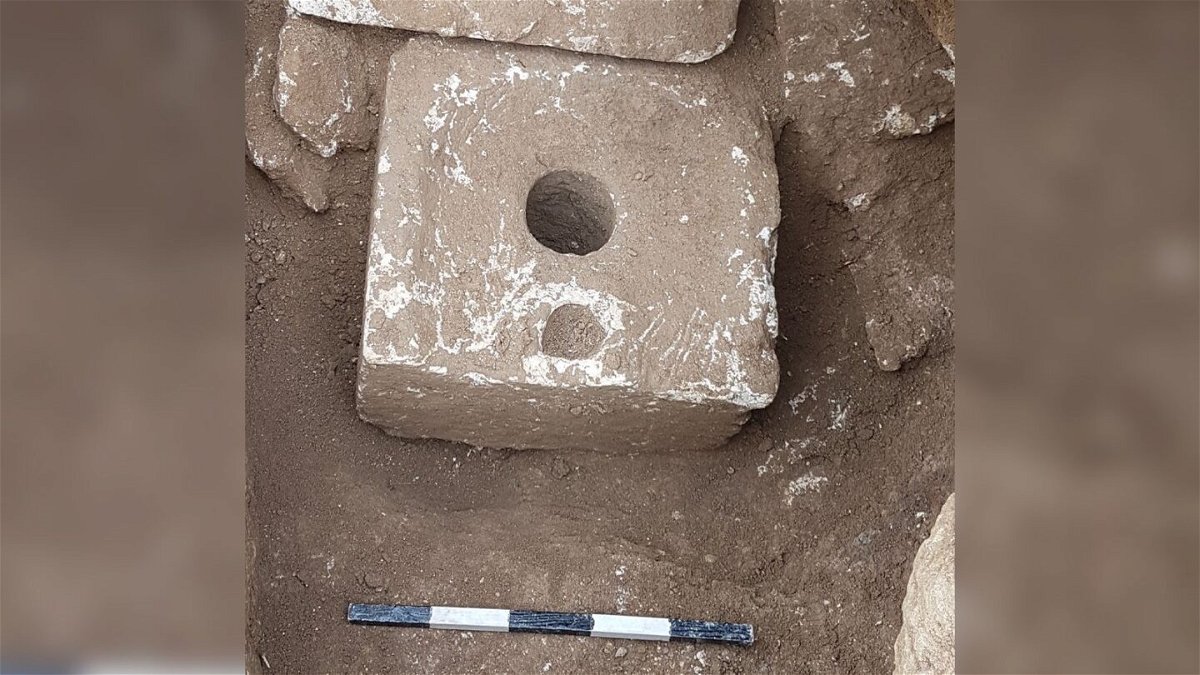Ancient toilets unearthed in Jerusalem reveal a debilitating and sometimes fatal disease

A stone toilet seat was excavated in 2019 south of Jerusalem in the neighborhood of Armon ha-Natziv.
By Katie Hunt, CNN
(CNN) — The Iron Age users of two ancient toilets in Jerusalem were not a healthy bunch, according to an analysis of poop samples from the 2,500-year-old latrines.
Researchers found traces of dysentery-causing parasites in material excavated from the cesspits below the two stone toilets that would have belonged to elite households in the city. Back then, Jerusalem was a vibrant political and religious center in the Assyrian empire and home to between 8,000 and 25,000 people.
It’s the earliest known evidence of a disease called Giardia duodenalis, although the infection, which causes diarrhea, abdominal cramps and weight loss, had previously been identified in Roman-era Turkey and in medieval Israel.
“Dysentery is spread by faeces contaminating drinking water or food, and we suspected it could have been a big problem in early cities of the ancient Near East due to over-crowding, heat and flies, and limited water available in the summer,” said Dr. Piers Mitchell, lead author of the study that published Thursday in the scientific journal Parasitology and an honorary fellow at the University of Cambridge’s Department of Archaeology, in a statement.
Most of those who die from dysentery caused by Giardia today are children, and chronic infection in kids can lead to stunted growth, impaired cognitive function and failure to thrive.
Ancient poop contains a trove of fascinating information
Ancient poop is a rich source of information for archaeologists and has revealed an Iron Age appetite for blue cheese, a mystery population on the Faroe Islands and the discovery that the builders of Stonehenge feasted on the internal organs of cattle.
Archaeologists excavating the latrines took samples from sediment in the cesspit beneath each toilet seat.
They found one seat south of Jerusalem in the neighborhood of Armon ha-Natziv at a mansion excavated in 2019. It likely dates from the days of King Manasseh, who ruled for 50 years in the mid-seventh century BC. Made of limestone, the toilet has a large central hole for defecating and an adjacent hole likely for male urination.
The other toilet seat studied, similar in design, was excavated in Jerusalem at a seven-room building known as the House of Ahiel, which would have been home to an upper-class family at the time.
The eggs of four types of intestinal parasites — tapeworm, pinworm, roundworm and whipworm — previously had been identified in the cesspit sediment. But the microorganisms that cause dysentery are fragile and extremely hard to detect, according to the new study.
To overcome this problem, the team used a biomolecular technique called ELISA in which antibodies bind onto proteins uniquely produced by particular species of single-celled organisms.
The researchers tested for Entamoeba, Giardia and Cryptosporidium: three parasitic microorganisms that are among the most common causes of diarrhea in humans — and behind outbreaks of dysentery. Tests for Entamoeba and Cryptosporidium were negative, but those for Giardia were repeatedly positive.
The Middle East was the region of the world where humans first created settlements, learned to farm and domesticate animals, and where the first large towns and cities sprang up. Cities such as Jerusalem likely would have been hot spots for disease outbreaks, and illnesses would have spread easily by traders and during military expeditions, according to the study.
“While they did have toilets with cesspits across the region by the Iron Age, they were relatively rare and often only made for the elite,” the study noted.
“Towns were not planned and built with a sewerage network, flushing toilets had yet to be invented and the population had no understanding of existence of microorganisms and how they can be spread.”
The-CNN-Wire
™ & © 2023 Cable News Network, Inc., a Warner Bros. Discovery Company. All rights reserved.

